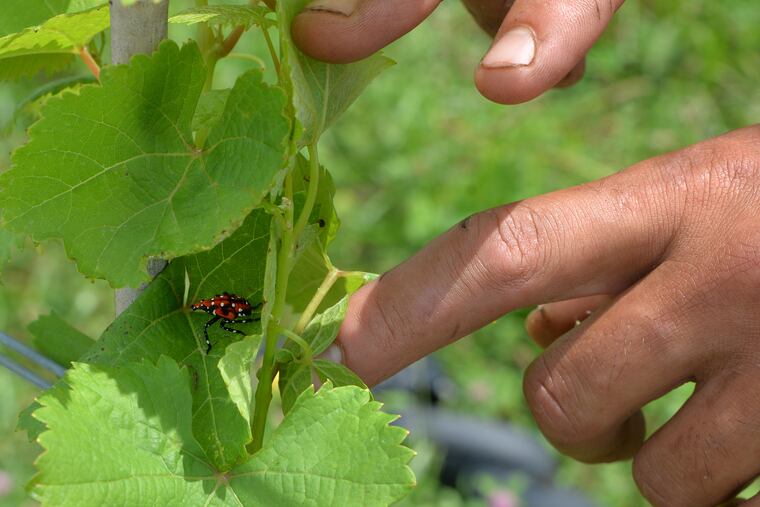Pa., N.J. vineyards brace for invasion of the spotted lanternflies
Spotted lanternflies love feeding on the sap of grapevines, which is bad news for local winegrowers.

Richard Blair knows what spotted lanternflies do to vineyards. He lost eight acres of grapevines to the invasive critters in 2017, three years after he first noticed them on his Setter Ridge Vineyards in Berks County. “We were at ground zero, so to speak,” Blair said.
Now he is fighting back as the voracious bugs move in on the new vines he just replanted after giving those eight acres time to recover.
“Insecticides are our main weapons at this point,” he said. Blair has plenty of company, as grape-growing peers in Pennsylvania and New Jersey try to beat back the wingless nymphs in midsummer before they become hungry adults in the fall.
Pennsylvania alone is home to more than 14,000 acres of vineyards and more than 300 wineries, which produce two million gallons of wine a year. Wineries in the state generate more than $475 million in tourism revenue every year. Before the COVID-19 pandemic, nearly 10,000 people worked at vineyards and wineries in the state.
But spotted lanternflies, invaders from Southeast Asia, particularly enjoy feeding on grapevines. As they pierce their targets to get at the plant sap, the bugs secrete what’s called honeydew, a sugary water substance that can lead to a plant-damaging mold. They’ve so far made their way through 26 of the 67 counties in Pennsylvania.
Heather Leach, an associate at Penn State Extension, the expert program for winemakers and farmers, has been working for two years with growers to help them deal with the spotted lanternflies.
Often, Leach’s work includes insecticide trials or finding other methods of killing spotted lanternflies. But she also has to spend a lot of time collecting basic data about their biology and behavior. The spotted lanternfly is a type of plant hopper, a group of insects that Leach says has been studied for evolution and genomics, but “not really anything to do with managing it as a pest.”
Leach has noticed patterns in the spotted lanternfly’s behavior that give her hope for some treatments. Most tend to congregate within the first 50 feet from the edge of a vineyard and prefer hanging out with other spotted lanternflies over being alone. “If you start to get predictability of behavior, then you can start to think about ways to exploit that,” Leach said.
One way of doing that is to concentrate insecticides at the edge of vineyards, rather than spray the whole area. Another might be to use exclusion netting to keep them off the vines entirely, though this is a pricier option. What she’s most excited about is a combination of the two: insecticide-impregnated netting. “It’s been a really hot research item,” she said. “We utilize this insecticide-treated netting at the edge of the field to kind of pull those bugs in and take that toxic dose without putting broadcast insecticide down.”
Kari Skrip, a co-owner of Clover Hill Vineyards & Winery in Lehigh County, owns six vineyards in the region, all of which have seen more lanternflies since 2017. “It’s really frightening when your whole business is based on an agricultural beginning,” she said.
So far, she’s used the EPA-approved insecticides but notes that many kill only the bugs that are sprayed directly. So after spraying, “you can wake up the next day and see a whole new population out there.” She worries about what this fall will bring, when the lanternflies are fully grown and able to feed on the vines. “We were and sort of still are in a helpless situation.”
Va La Vineyards owner Anthony Vietri first saw a spotted lanternfly on his property in Avondale last September and found egg sacs as he was pruning in January — a sign that he’ll likely see a lot more adult lanternflies this fall. Yet, no matter how vigilant he is, he can still get more of them migrating from areas around his vineyard. “If I kill them all, it’s not going to solve our problem because they’re just going to come from another place,” he said.
Vietri hopes, instead, that he can target insecticides on the egg sacs in the winter and spring, and the wingless nymphs in midsummer to limit the adult population in the fall. But he would prefer natural treatments over insecticides. “There’s talk of parasitic wasps and some bacterias that might be able to kill them,” he said. “I’m really waiting to have those come online so we can get the populations to a manageable level.”
Larry Coia of Coia Vineyards hasn’t seen the spotted lanternflies yet on his property in Vineland, N.J., but he knows they’re coming, and hopes for biological predators to be ready soon. “I’m hoping that within a couple of years, when I might have that significant pressure from the spotted lanternflies, that these treatments might be available,” he said.
Previous invasive species, such as Japanese beetle, “were lesser threats than this current one because it can kill the vine,” said Coia. Instead of losing only one year of fruit, growers would have to start over and replant. Coia notes that new vines and trellises would cost him anywhere from $10,000 to $15,000 just to start, and take as long as seven years to be profitable again.
For Blair and Setter Ridge, starting over was worth it to continue his family business through his daughter. “This is what you do,” he said. “I may not be here for a long time, but I have my daughter, and she’s got a long time to go with this as her business.”